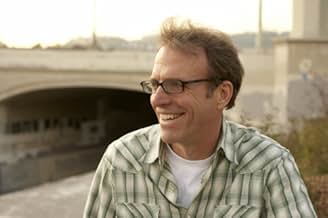IMDb-BEWERTUNG
7,4/10
28.873
IHRE BEWERTUNG
Kirby Dicks Exposé über die amerikanische Filmbewertungsstelle.Kirby Dicks Exposé über die amerikanische Filmbewertungsstelle.Kirby Dicks Exposé über die amerikanische Filmbewertungsstelle.
- Regie
- Drehbuch
- Hauptbesetzung
- Auszeichnungen
- 4 Gewinne & 3 Nominierungen insgesamt
Clark Baker
- Self - Private Investigator
- (as Clark)
Empfohlene Bewertungen
This movie is informative, but also funny and clever and kind of mind-blowing. It's not for the faint of heart because it contains quite a bit of graphic footage to illustrate the point that the ratings board is totally arbitrary (in fact, one former board member says there is absolutely no training or standards -- you come in on your first day and start to rate movies). That may seem not to matter, but it matters quite a bit to the film makers whose films are being rated and several appear in the film and make very strong arguments for why the rating their film received was unfair. There are also interviews with several other people (like a free speech lawyer) who add context to Kirby Dick's expose. This really is a must see for anyone who cares about movies and it's a lot of damn fun too.
Fast paced, absorbing, at times comical exposé of the Motion Picture Association of America (MPAA) film rating system. While it is in name a "voluntary" system, i.e., a filmmaker can choose whether to submit a film to MPAA for rating purposes, in fact the theater chains that promise wide exposure and revenues for a film they screen will rarely touch a movie that is unrated or that receives the most restrictive rating, NC-17 (no "child" 17 or younger admitted under any circumstances.) The ratings are allegedly created by a panel of "average" parents of school age children, according to long time MPAA CEO, Jack Valenti, and other officials. There are no experts, e.g., no psychologists who study the impact of media on kids' attitudes and behavior. Panel members are selected by the rating committee chair, Joan Graves. Members' identities are kept secret to "avoid pressures" on their decision making.
Among other things, director Kirby Dick discovers that (a) there are no explicit criteria or guidelines for ratings; (b) ditto for selection of raters (who, if they work full time, receive annual salaries of $30,000); (c) one recent rater was childless; the children of several others were adults; (d) raters frequently discuss films with industry representatives, arguably the most important source of "pressure" on their decisions; (e) majority votes determine the recommended rating, but these votes are not binding; (f) in case of ties (there are eight voting members, including Ms. Graves), Ms. Graves also is empowered to cast a tie-breaking judgment; and (g) there is an appeals process.
However, the appeals board is composed exclusively of representatives of the major studios, distributors and exhibition chains, and rarely do they controvert the initial rating. This is no surprise, since the MPAA is entirely financed by the six largest studios (responsible for 90% of the films released domestically) and their conglomerate corporate media owners (who control 95% of all media outlets in the U.S.) Details of all rating board and appeal decisions are kept secret. To create the illusion of transparency, two clergymen, representing Roman Catholics and Protestants, always sit in as observers at appeals hearings. But they too are required not to disclose information on the appeal decision process.
Compared to a number of other rating systems that exist in various countries worldwide, the MPAA approach is by far the most secretive, and contrary to every other system, it is far more restrictive of sexual content than violence. Kirby Dick also cites examples that strongly suggest greater bias (i.e., greater likelihood of getting an NC-17 rating) against films depicting gay/lesbian sex scenes than those with heterosexual scenes.
Dick mixes illustrative film clips, talking heads, historical notes on the evolution of ratings, a rundown on what appear to be the implicit criteria for ratings; a stalking investigation to discover the identities of raters and appeal board members; and his personal experience in submitting an earlier cut of this film to MPAA for a rating (it got an NC-17 for sexually explicit content). Atom Egoyan, Kimberly Peirce, Kevin Smith and John Waters are among independent filmmakers interviewed by Dick. Ms. Peirce raises the interesting notion that MPAA ratings may also be more biased against films with scenes connoting female sexual pleasure than films showing male pleasure.
Dick generally maintains a tone of wry humor, especially in showing us his day-by-day use of private investigators to track down and identify raters. There's almost a Keystone Cops flavor to the stalking antics of the women PIs he has hired, with Dick along for the ride. His re-creation of phone conversations with Joan Graves and the MPAA Chief Counsel, when he protests the rating of his own film, are also as funny as they are biased. (He uses animation to visually depict these officials as mean spirited grumps in split screen scenes that simultaneously show real time footage of Dick himself at his end of these conversations.) Dick is less successful in his review of information suggesting the implicit or inferable criteria raters use, based on film content and actual ratings. He zips through too much information too fast for anybody to absorb. Still, this is a bravura piece of advocacy journalism. The film gives us ample information to conclude that the MPAA system of corporate control of ratings, when combined with control of film distribution and screening based on these ratings, effectively results in a clever censorship arrangement that would certainly violate First Amendment rights were it not for the illusion of "voluntariness" that is perhaps the most ingenious aspect of this system.
Anybody is free to make a film about anything, of course. But whether it will be screened, or even advertised, let alone able to return revenues sufficient to defray the costs of production, is a very carefully controlled process. And what is the point of making a film that will not be seen? As in political campaigning, free speech is hardly free. Those with the most corporate clout rule both the campaigning and movie making businesses. What's worse, in our characteristic American manner, we shrink puritanically from sex on screen but remain inured to the effects of violence. My grade: 7.5/10 (low B+) (Seen on 09/10/06)
Among other things, director Kirby Dick discovers that (a) there are no explicit criteria or guidelines for ratings; (b) ditto for selection of raters (who, if they work full time, receive annual salaries of $30,000); (c) one recent rater was childless; the children of several others were adults; (d) raters frequently discuss films with industry representatives, arguably the most important source of "pressure" on their decisions; (e) majority votes determine the recommended rating, but these votes are not binding; (f) in case of ties (there are eight voting members, including Ms. Graves), Ms. Graves also is empowered to cast a tie-breaking judgment; and (g) there is an appeals process.
However, the appeals board is composed exclusively of representatives of the major studios, distributors and exhibition chains, and rarely do they controvert the initial rating. This is no surprise, since the MPAA is entirely financed by the six largest studios (responsible for 90% of the films released domestically) and their conglomerate corporate media owners (who control 95% of all media outlets in the U.S.) Details of all rating board and appeal decisions are kept secret. To create the illusion of transparency, two clergymen, representing Roman Catholics and Protestants, always sit in as observers at appeals hearings. But they too are required not to disclose information on the appeal decision process.
Compared to a number of other rating systems that exist in various countries worldwide, the MPAA approach is by far the most secretive, and contrary to every other system, it is far more restrictive of sexual content than violence. Kirby Dick also cites examples that strongly suggest greater bias (i.e., greater likelihood of getting an NC-17 rating) against films depicting gay/lesbian sex scenes than those with heterosexual scenes.
Dick mixes illustrative film clips, talking heads, historical notes on the evolution of ratings, a rundown on what appear to be the implicit criteria for ratings; a stalking investigation to discover the identities of raters and appeal board members; and his personal experience in submitting an earlier cut of this film to MPAA for a rating (it got an NC-17 for sexually explicit content). Atom Egoyan, Kimberly Peirce, Kevin Smith and John Waters are among independent filmmakers interviewed by Dick. Ms. Peirce raises the interesting notion that MPAA ratings may also be more biased against films with scenes connoting female sexual pleasure than films showing male pleasure.
Dick generally maintains a tone of wry humor, especially in showing us his day-by-day use of private investigators to track down and identify raters. There's almost a Keystone Cops flavor to the stalking antics of the women PIs he has hired, with Dick along for the ride. His re-creation of phone conversations with Joan Graves and the MPAA Chief Counsel, when he protests the rating of his own film, are also as funny as they are biased. (He uses animation to visually depict these officials as mean spirited grumps in split screen scenes that simultaneously show real time footage of Dick himself at his end of these conversations.) Dick is less successful in his review of information suggesting the implicit or inferable criteria raters use, based on film content and actual ratings. He zips through too much information too fast for anybody to absorb. Still, this is a bravura piece of advocacy journalism. The film gives us ample information to conclude that the MPAA system of corporate control of ratings, when combined with control of film distribution and screening based on these ratings, effectively results in a clever censorship arrangement that would certainly violate First Amendment rights were it not for the illusion of "voluntariness" that is perhaps the most ingenious aspect of this system.
Anybody is free to make a film about anything, of course. But whether it will be screened, or even advertised, let alone able to return revenues sufficient to defray the costs of production, is a very carefully controlled process. And what is the point of making a film that will not be seen? As in political campaigning, free speech is hardly free. Those with the most corporate clout rule both the campaigning and movie making businesses. What's worse, in our characteristic American manner, we shrink puritanically from sex on screen but remain inured to the effects of violence. My grade: 7.5/10 (low B+) (Seen on 09/10/06)
America is the land of the free, so in order to constrain people to do what you want them to do, you have to let them think it's their choice. How do you do that? You create a completely anonymous committee, supposedly composed of concerned parents, to rate the films that appear and, depending on that rating, they will get more or less media coverage, distribution, target audience size. You also finance this body with the money of the seven largest film studios in the US. This functioning censorship committee is called the MPAA.
The film is highly biased, to a point where it gets a little annoying, but the information contained in it is sound, proved and makes one think about the way public opinion is manipulated, ever so slightly, towards a desired average point of view. If you ever wondered how Americans can seem so ordinary, yet have completely different opinions about the same subjects as any other people, then this movie will answer part of that question. Very insightful is the presentation of the seven major film studios who own 95% of the American film industry, parts of larger conglomerates that own 90% of all mass-media. Also interesting, the role of the clergy in movie rating. Yes, I did say clergy, as in priests. In the appeals commission there are always an episcopalian priest and a catholic one. No other religions get to add their input.
A must see movie, not a conspiracy theory film, but certainly one that is against the system. The system here being the absurd movie rating system of the MPAA.
The film is highly biased, to a point where it gets a little annoying, but the information contained in it is sound, proved and makes one think about the way public opinion is manipulated, ever so slightly, towards a desired average point of view. If you ever wondered how Americans can seem so ordinary, yet have completely different opinions about the same subjects as any other people, then this movie will answer part of that question. Very insightful is the presentation of the seven major film studios who own 95% of the American film industry, parts of larger conglomerates that own 90% of all mass-media. Also interesting, the role of the clergy in movie rating. Yes, I did say clergy, as in priests. In the appeals commission there are always an episcopalian priest and a catholic one. No other religions get to add their input.
A must see movie, not a conspiracy theory film, but certainly one that is against the system. The system here being the absurd movie rating system of the MPAA.
Kirby Dick's expose of the MPAA's ratings process only confirms the suspicion that motion picture ratings are virtually worthless, arbitrarily assigned by an elite panel who purport to have our country's children's best interests at heart, but who seem to think that an exposed breast is more harmful to them than seeing a gunshot to the head.
It's absolutely infuriating that the country's churches have a seat on the ratings boards and a say in what content is or is not suitable for consumption. It's infuriating that an NC-17 rating exists at all (the board is essentially usurping the judgement and decision-making abilities of parents), but doubly infuriating that it's used as a punishment to "encourage" filmmakers to alter their films so that they're more palatable for mainstream film goers. For a while I was kind of sad that home video and the Internet seems to be supplanting movie theatres as the preferred venue for watching films, but now I appreciate the democratizing effect of companies like Netflix and Blockbuster, who have made great filmmakers less reliant on corporate theatre chains to get their films distributed and seen.
As a documentary, "This Film Is Not Yet Rated" is rather disorganized. Dick has good points to make, but their impact is blunted by tangents and off-topic tirades. Dick hires a private detective to track down the identities of the ratings board, and spends far too much of his 96 minutes following the details of that investigation. On the plus side, it's great to see directors and actors like Kimberly Peirce, Maria Bello and John Waters given a venue to vent their frustrations at the ratings practice.
One of the main points Dick makes, and one I heartily agree with, is that the ratings board focuses far more energy on censoring sex in films than they do violence, a point that is unintentionally driven home by none other than the ratings board chairman herself towards the film's climax. Dick asks why his documentary received an NC-17 rating and she cites the sexual content that appears in some of the clips of films that have received NC-17 ratings sprinkled throughout the documentary. She seems to have no problem with some of the very violent content included in clips from some of those very same movies. What an idiot.
Grade: B+
It's absolutely infuriating that the country's churches have a seat on the ratings boards and a say in what content is or is not suitable for consumption. It's infuriating that an NC-17 rating exists at all (the board is essentially usurping the judgement and decision-making abilities of parents), but doubly infuriating that it's used as a punishment to "encourage" filmmakers to alter their films so that they're more palatable for mainstream film goers. For a while I was kind of sad that home video and the Internet seems to be supplanting movie theatres as the preferred venue for watching films, but now I appreciate the democratizing effect of companies like Netflix and Blockbuster, who have made great filmmakers less reliant on corporate theatre chains to get their films distributed and seen.
As a documentary, "This Film Is Not Yet Rated" is rather disorganized. Dick has good points to make, but their impact is blunted by tangents and off-topic tirades. Dick hires a private detective to track down the identities of the ratings board, and spends far too much of his 96 minutes following the details of that investigation. On the plus side, it's great to see directors and actors like Kimberly Peirce, Maria Bello and John Waters given a venue to vent their frustrations at the ratings practice.
One of the main points Dick makes, and one I heartily agree with, is that the ratings board focuses far more energy on censoring sex in films than they do violence, a point that is unintentionally driven home by none other than the ratings board chairman herself towards the film's climax. Dick asks why his documentary received an NC-17 rating and she cites the sexual content that appears in some of the clips of films that have received NC-17 ratings sprinkled throughout the documentary. She seems to have no problem with some of the very violent content included in clips from some of those very same movies. What an idiot.
Grade: B+
Since the Hays Code, filmmakers have had a lot more freedom over the content of their films. However, the MPAA ratings board still does exercise a certain de facto censorship power. Most people do not realize this.
"This Film is not Yet Rated" exposes the arbitrariness, secrecy, and bias of the MPAA ratings board and makes the viewer question why movies receive the ratings they do.
Kirby Dick puts together a nice cross-section of directors and "talking heads" who discuss the MPAA ratings board's biases when it comes to realism, sex, violence, gay themes, and other taboo issues in films.
Dozens of major directors have had problems with the MPAA ratings board - they either received the NC-17 (or the old "X") rating or had to cut their films to meet the requirements of the ratings board. Some examples are: Kubrick, Tarantino, Lynch, Woo, Friedkin, Peckinpah, Aronofsky, and countless others.
This film exposes the fact that the ratings board is made up of people who are given NO criteria and NO training for rating films, so they basically use their own personal (and obviously heavily biased) judgments to decide what rating a particular movie should receive.
This is an important film because so few people realize how movies are rated in the U.S. Even fewer realize how problematic (biased, anti-democratic, non-transparent, not accountable) our system is.
It is also well put together, so it is easier to watch than most documentaries.
I would have liked to have heard more comparisons between the U.S. rating system and others worldwide, something that was only briefly touched upon.
9 out of 10
"This Film is not Yet Rated" exposes the arbitrariness, secrecy, and bias of the MPAA ratings board and makes the viewer question why movies receive the ratings they do.
Kirby Dick puts together a nice cross-section of directors and "talking heads" who discuss the MPAA ratings board's biases when it comes to realism, sex, violence, gay themes, and other taboo issues in films.
Dozens of major directors have had problems with the MPAA ratings board - they either received the NC-17 (or the old "X") rating or had to cut their films to meet the requirements of the ratings board. Some examples are: Kubrick, Tarantino, Lynch, Woo, Friedkin, Peckinpah, Aronofsky, and countless others.
This film exposes the fact that the ratings board is made up of people who are given NO criteria and NO training for rating films, so they basically use their own personal (and obviously heavily biased) judgments to decide what rating a particular movie should receive.
This is an important film because so few people realize how movies are rated in the U.S. Even fewer realize how problematic (biased, anti-democratic, non-transparent, not accountable) our system is.
It is also well put together, so it is easier to watch than most documentaries.
I would have liked to have heard more comparisons between the U.S. rating system and others worldwide, something that was only briefly touched upon.
9 out of 10
Wusstest du schon
- WissenswertesThe MPAA announced that starting in March of 2007, it will change their policy and allow filmmakers to cite other film's ratings as comparison. The MPAA will also provide information about the demographics of its board.
- Zitate
John Waters: I also heard on 'A Dirty Shame' - and I have no proof of this - that there were doctors involved... and that some of the kinkier terms, like felching and stuff, that they explained to the MPAA what felching meant. Now, I would like to have heard that because felching, no one has ever done felching. Felching is when you fuck someone and suck your own cum out of their asshole. Well, I know a lot of perverts and I don't know anyone who's done that.
- Crazy CreditsAt the end credits a count of what the film shows: FUCKS(OR DERIVATIONS OF): 20 MOTHERFUCKERS: 3 HUMPS: 220 NIPPLES: 10 INTERCOURSE WITH PIE: 1 CARTOONS/PUPPETS IN SEXUAL POSITIONS: 15 SPLOSHING: 1 FELCHING: 0
- VerbindungenEdited into This Film Is Not Yet Rated: Deleted Scenes (2009)
- SoundtracksAppeals Members
Written and Performed by Michael S. Patterson (ASCAP)
Courtesy of Absynthe Zelery Music (ASCAP)
Top-Auswahl
Melde dich zum Bewerten an und greife auf die Watchlist für personalisierte Empfehlungen zu.
- How long is This Film Is Not Yet Rated?Powered by Alexa
Details
- Erscheinungsdatum
- Herkunftsländer
- Sprache
- Auch bekannt als
- Los censores de Hollywood
- Drehorte
- Produktionsfirmen
- Weitere beteiligte Unternehmen bei IMDbPro anzeigen
Box Office
- Bruttoertrag in den USA und Kanada
- 306.845 $
- Eröffnungswochenende in den USA und in Kanada
- 30.664 $
- 3. Sept. 2006
- Weltweiter Bruttoertrag
- 347.240 $
- Laufzeit1 Stunde 38 Minuten
- Farbe
- Sound-Mix
- Seitenverhältnis
- 1.85 : 1
Zu dieser Seite beitragen
Bearbeitung vorschlagen oder fehlenden Inhalt hinzufügen

Oberste Lücke
What is the Brazilian Portuguese language plot outline for This Film Is Not Yet Rated (2006)?
Antwort






























